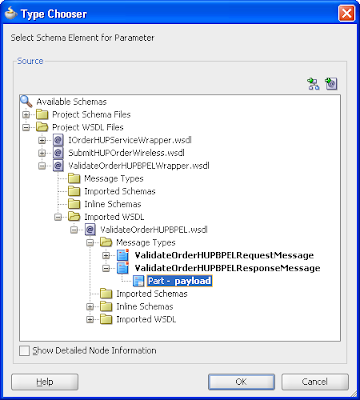Custom XPath functions provide a great way of handling functionality which cannot be performed using standard set of available functions. Oracle SOA suite comes with many functions which include standard XPath functions as well as SOA and BPEL XPath extension functions. However, many times a situation comes where we wish that so and so function was available.
In such case, arguably custom XPath is the best way to deal with.
For detail, please look at here http://tech-learnings.blogspot.ca/2010/05/using-custom-xpath-functions.html.
Friday, May 18, 2012
BPEL - Sorting data using xsl:sort
In SOA 11g, there is a new XSL-Construct for sorting the input nodes. This is a basic XSLT construct (element) which was missing earlier.
As the w3 standard defines, this construct cannot be used independently, but can be used along with xsl:for-each(or xsl:apply-templates)
It is used to sort the input data based upon some id or text(called as sort-key).
This can be very useful functionality in scenarios where one needs to process some data in a specific sequence.
For detail, please find more here http://tech-learnings.blogspot.ca/2010/05/sorting-data-using-xslsort.html.
As the w3 standard defines, this construct cannot be used independently, but can be used along with xsl:for-each(or xsl:apply-templates)
It is used to sort the input data based upon some id or text(called as sort-key).
This can be very useful functionality in scenarios where one needs to process some data in a specific sequence.
For detail, please find more here http://tech-learnings.blogspot.ca/2010/05/sorting-data-using-xslsort.html.
Labels:
BPEL,
BPM,
Oracle Fusion Middleware,
SOA,
SOA/SCA/SDO
Tuesday, May 15, 2012
SOA - Add additional source to tranformation manually
In SOA suite, we can select the source and target at the beginning of transformation creation. When everything is done, we found we need more one source, how should we do to add additional sources to an existing XSLT map?
To add additional source, right-click the source panel to display the context menu.
Select Add Source and enter a parameter name for the source (the name can also be qualified by a namespace and prefix) in the Add Source dialog.
I n the Source Schema section, click Select to select a schema for the new source by the Type Chooser dialog.
Select or import the appropriate schema or WSDL file for the parameter in the same manner as when creating a new XSLT map. For this example, the response of validateOrderHup from the WSDL is selected.
Source type - can be XSD or WSDL
Schema details - location, root element name and namespace
Parameter name - follow naming convention VARIABLE_NAME.VARIABLE_PART_NAME .
The additional sources are defined as global parameters and have schema files defining their structure. The follow line will be added to the XSLT map file.
<xsl:param name="validateOrderHUP_OnMessage_processResponse_InputVariable.payload"/>
NOTE: The XSL has no knowledge of BPEL variables. When you add an additional sources in XSL design time, ensure you also add the additional source in the transform activity of a BPEL process. (Otherwise, you will get an error message )
This can be done by adding the variable using the green plus symbol in the transform activity or you can manually change it based on the follow format.
Format: ora:doXSLTransformForDoc('url_to_xslt',input,['paramQname',paramValue]*)
url_to_xslt - Specifies the XSL style sheet URL. (occurrence = 1)
input - Specifies the input variable name. (occurrence = 1)
paramQname - Specifies the parameter QName. (occurrence >= 1 )
paramValue - Specifies the value of the parameter. (occurrence >= 1 , same as paramQname )
ora:doXSLTransformForDoc("xsl/Generate_Request.xsl", $inputVariable.payload, "validateOrderHUP_OnMessage_processResponse_InputVariable.payload", $validateOrderHUP_OnMessage_processResponse_InputVariable.payload)
If we manually to add the above things, we need to handle the schema namespace properly and add them to the list of referred namespaces in the stylesheet tag using xmlns tag.
To add additional source, right-click the source panel to display the context menu.
Select Add Source and enter a parameter name for the source (the name can also be qualified by a namespace and prefix) in the Add Source dialog.
Select or import the appropriate schema or WSDL file for the parameter in the same manner as when creating a new XSLT map. For this example, the response of validateOrderHup from the WSDL is selected.
Change to the source view and you can see the follow high-lighted code was added.
Source type - can be XSD or WSDL
Schema details - location, root element name and namespace
Parameter name - follow naming convention VARIABLE_NAME.VARIABLE_PART_NAME .
The additional sources are defined as global parameters and have schema files defining their structure. The follow line will be added to the XSLT map file.
<xsl:param name="validateOrderHUP_OnMessage_processResponse_InputVariable.payload"/>
NOTE: The XSL has no knowledge of BPEL variables. When you add an additional sources in XSL design time, ensure you also add the additional source in the transform activity of a BPEL process. (Otherwise, you will get an error message )
This can be done by adding the variable using the green plus symbol in the transform activity or you can manually change it based on the follow format.
Format: ora:doXSLTransformForDoc('url_to_xslt',input,['paramQname',paramValue]*)
input - Specifies the input variable name. (occurrence = 1)
paramQname - Specifies the parameter QName. (occurrence >= 1 )
paramValue - Specifies the value of the parameter. (occurrence >= 1 , same as paramQname )
ora:doXSLTransformForDoc("xsl/Generate_Request.xsl", $inputVariable.payload, "validateOrderHUP_OnMessage_processResponse_InputVariable.payload", $validateOrderHUP_OnMessage_processResponse_InputVariable.payload)
If we manually to add the above things, we need to handle the schema namespace properly and add them to the list of referred namespaces in the stylesheet tag using xmlns tag.
Subscribe to:
Comments (Atom)



